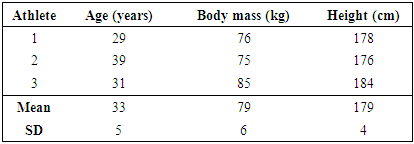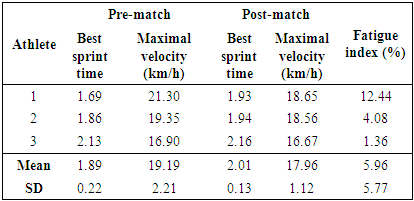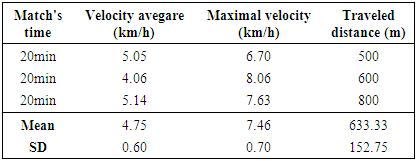-
Paper Information
- Previous Paper
- Paper Submission
-
Journal Information
- About This Journal
- Editorial Board
- Current Issue
- Archive
- Author Guidelines
- Contact Us
International Journal of Sports Science
p-ISSN: 2169-8759 e-ISSN: 2169-8791
2018; 8(2): 63-66
doi:10.5923/j.sports.20180802.04

Brazilian Footvolley: A Displacement Screening Study of a Professional National Match
Rafael Grazioli1, Martinho Inácio2, Natália Nunes1, Leonel Villeroy1
1Villeroy Team, Porto Alegre, Brazil
2São José Sport Club, Porto Alegre, Brazil
Correspondence to: Rafael Grazioli, Villeroy Team, Porto Alegre, Brazil.
| Email: |  |
This work is licensed under the Creative Commons Attribution International License (CC BY).
http://creativecommons.org/licenses/by/4.0/

The footvolley practice has been growing around the world. However, there is no displacement and neuromuscular information in response to a match for helping coaches on training prescription. Current study aimed to screen distance and fatigue-induced parameters of a professional Brazilian footvolley match. Three professional athletes participated of the present study. GPS data was collected during all a single match and 10-meter acceleration information was collected pre- and post-match. The athletes presented 5.96% of velocity decreases in response to a match and displaced an average distance of 633 meters and the average intensity was 39.4% of the maximal acceleration capacity. Taking into account the association between total distance, fatigue index, and intensity, we could speculate that, although the reduced distance and intensity, the fatigue index was relevant in the match. The current study brings important practical suggestions regarding an official and leisure modality.
Keywords: Footvolley, Fatigue, Sand training, GPS
Cite this paper: Rafael Grazioli, Martinho Inácio, Natália Nunes, Leonel Villeroy, Brazilian Footvolley: A Displacement Screening Study of a Professional National Match, International Journal of Sports Science, Vol. 8 No. 2, 2018, pp. 63-66. doi: 10.5923/j.sports.20180802.04.
1. Introduction
- It is well known that professional soccer includes lower limb power and proper strength and conditioning demands (Barnes, Archer, Hogg, Bush, & Bradley, 2014). Diverse global training methods with the ball have been applied for developing the above mentioned variables. In Brazil, an interesting sport modality called “footvolley” is largely practiced by soccer athletes as a leisure moment (Figure 1). However, this specific modality has been growing in the last 10 years and became an official regional sport with relevant competitions in Brazil. The “footvolley” is applied in a sand environment with volleyball net in an area of 18x9 meters (Figure 2). The rules are the same of volleyball (i.e., 3 touches, point is gained when the ball touches the ground), the difference is that only two participants play for each side and the ball cannot touch hands.
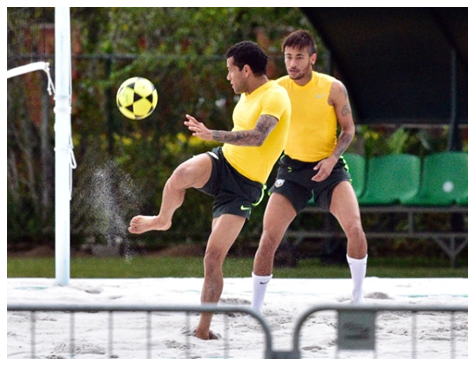 | Figure 1. Brazilian soccer players (Daniel Alves and Neymar Junior) playing footvolley – by Gaspar Nóbrega |
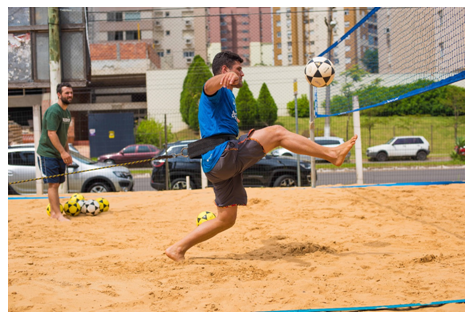 | Figure 2. Footvolley environment and training (Villeroy Team) – by Vicente Vaccaro |
2. Methods
- ParticipantsThe sample was three professional footvolley players from Villeroy Team (33 ± 5 years old; 79 ± 6 kg; 179 ± 4 cm), who were asked to voluntarily participate of the assessments in the official match day. After recruitment and acceptance, individuals received a consent form to read and sign if they agreed. This study was performed in accordance with the Helsinki Declaration. The inclusion criteria were (a) men between 18 and 40 years (b) without neuromuscular, cardiovascular, pulmonary, or metabolic diseases, (c) no use of any type of substances that could improve the neuromuscular performance, and (d) with no training interruptions during the past year. The participants played the same match (Athlete 1 and 2 vs. Athlete 3 and other who did not participate). Acceleration capacity and GPS parametersBefore and immediately after the match, participants executed three 10-meter sprint bouts with 30 seconds of rest between each attempt for measuring maximal acceleration capacity utilizing photocells (Speed Test 6.0 Std, São Paulo, Brazil). They warmed up during 5 minutes of skeeping and submaximal sprints. All athletes were familiarized with the test. The maximal sprint bouts were conducted in the same environment condition of the match (i.e., sand). Maximal (all-out) effort was required for each participant, being verbal encouragement implemented during all repetitions. Furthermore, the athletes used a specific trunk vest for coupling the GPS (QStartz 5Hz, BT-Q1300ST, Taiwan) during all match’s time (i.e., 20 minutes).
3. Results
- Because of the descriptive study’s purpose and reduced sample, we did not use statistical analyze. Moreover, the current data are specific for practical implications and only suggestive for training considerations. All data are showed with mean and standard deviation (SD). Table 1 presents individual physical characteristics. Table 2 presents pre- to post-match 10-meter sprint performance and fatigue index. Table 3 presents GPS parameters. Table 4 presents match’s intensity data.
|
|
|
|
4. Discussion and Conclusions
- The current investigation proposed to identify displacement characteristics of a premature and great sport modality in Brazil in which coaches have no representative neuromuscular data to help training prescription. Despite our reduced sample, the present study aimed to only offer practical and experienced information of a growing sport. One of our main results was the fatigue index information because athletes showed 5.96% of acute velocity decreases in response to a match of 20 minutes (Figure 3). In comparison to soccer, this is an interesting fatigue index value, once elite soccer players may show an acute sprint performance decrease of 2.6% after playing 45 minutes (Edholm, Krustrup, & Randers, 2014). Furthermore, maximal knee extension torque seems to decrease approximately 8% after 90 minutes in professional soccer matches (Nédélec et al., 2012). Of course, present study did not evaluate maximal single-joint moment and the fatigue indexes can be completely different between maximal knee extension torque, jumps, and sprint performance (Sánchez-Medina & González-Badillo, 2011; Haugen, Tønnessen, Hisdal, & Seiler, 2014; Morin, Samozino, Edouard, & Tomazin, 2011; Pinto, Blazevich, Andersen, Mil-Homens, & Pinto, 2017).
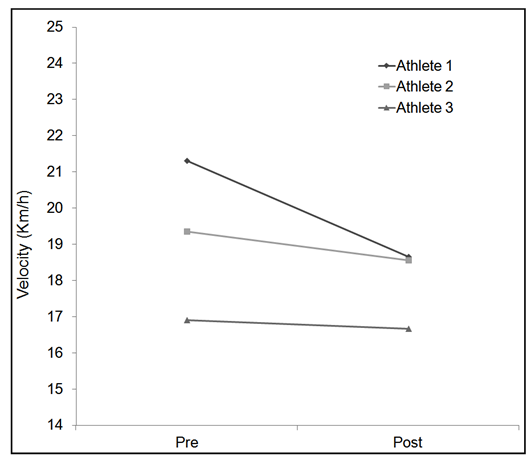 | Figure 3. Individual sprint performance decreases |
ACKNOWLEGMENTS
- We gratefully acknowledge to the subjects who participated in this research and made this project possible. Moreover, we acknowledge all Villeroy Team collaborators.
 Abstract
Abstract Reference
Reference Full-Text PDF
Full-Text PDF Full-text HTML
Full-text HTML